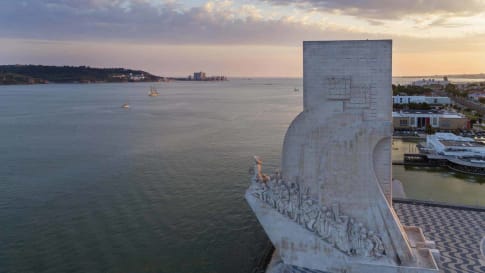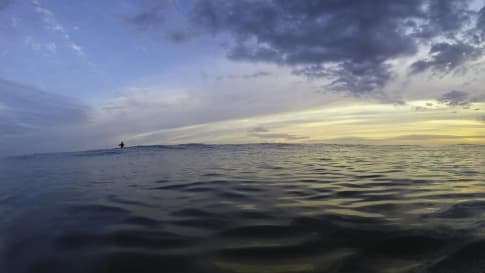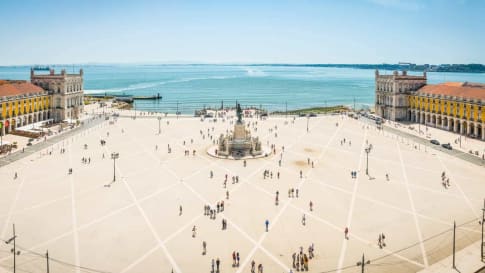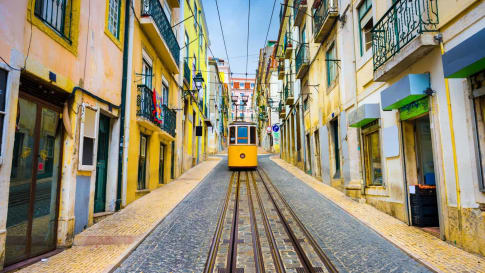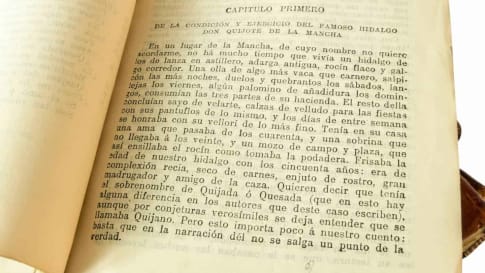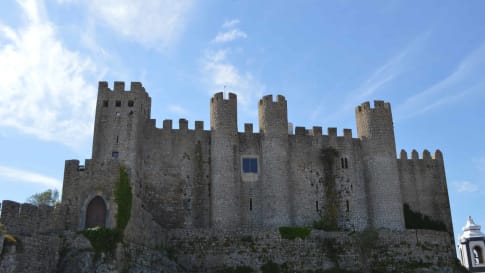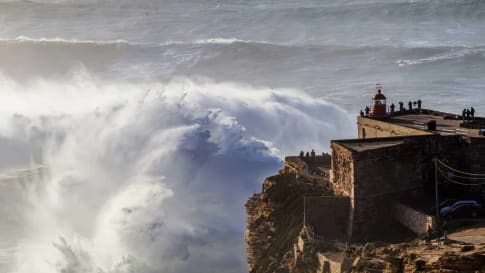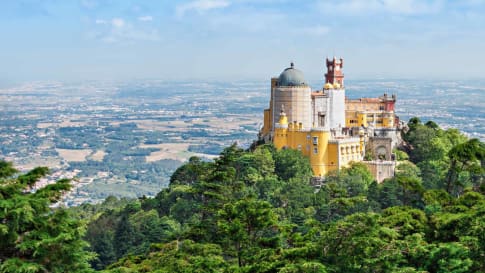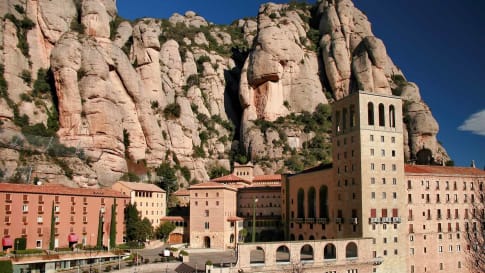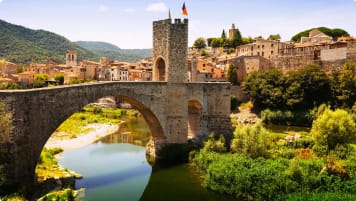Lisbon & Barcelona small group tour
An escorted tour for like minded people that provides mature couples and solo travellers with daily itineraries that provide authentic experiences with qualified local guides in the great cities of Lisbon and Barcelona over 21 days. For solo travellers a nominal single supplement is charged.
From $9,884USD
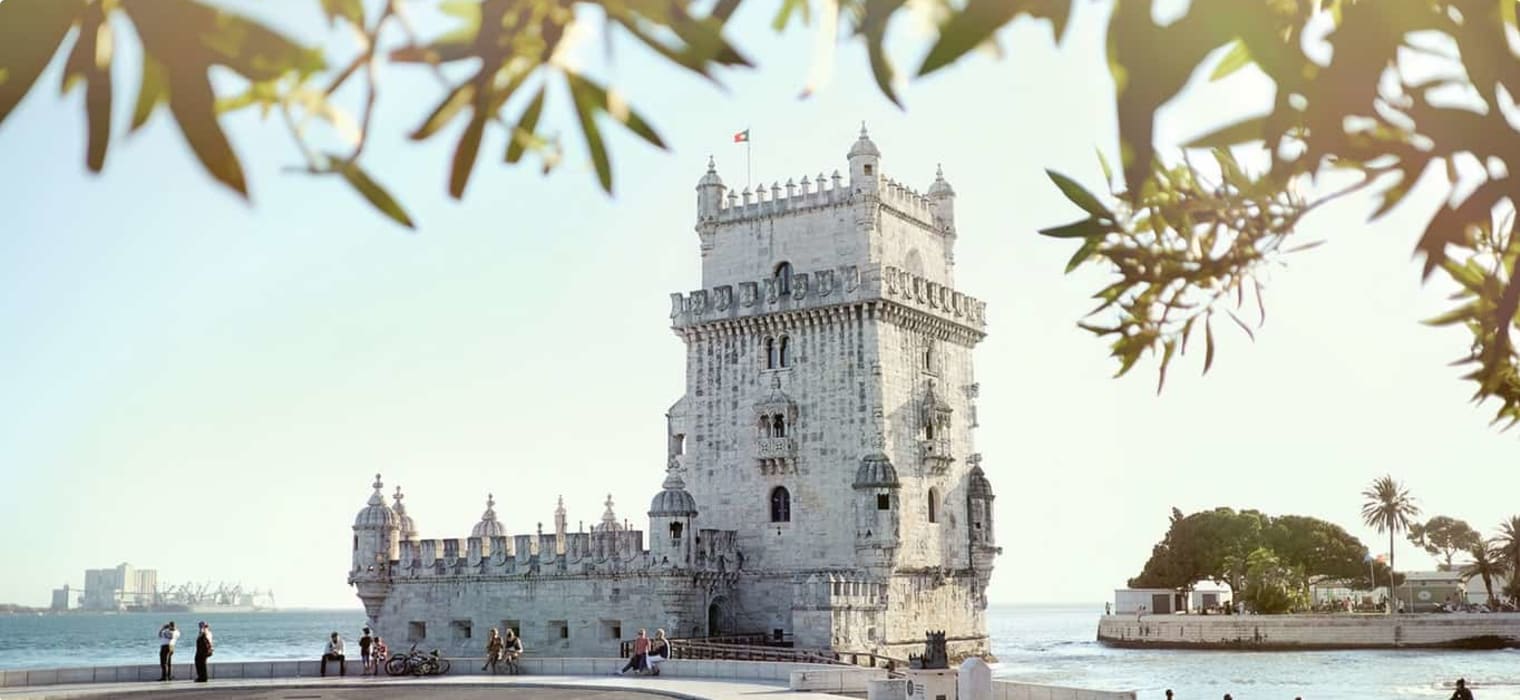
Highlights
- 1. See the colourful Pena Palace, located at the top of the hill in the Sintra Mountains and celebrated as the grandest example of Romantic architecture.
- 2. Visit the Fabrica dos Pasteis de Belem, which has been baking the world-famous Portuguese custard tart since 1837.
- 3. Explore the city of Montserrat, and travel by cable car up to an abbey nestled in the mountain to visit the Black Madonna.
- 4. View the Gaudi-designed monuments in Barcelona.
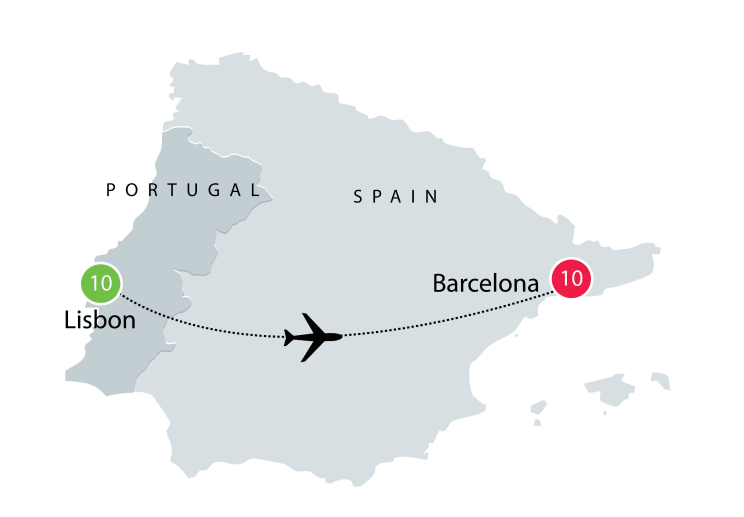
Departure Dates
| Departure Date | Price |
|---|---|
| 09 June 2025 Ends 29 June 2025 • 21 days $9,884 Twin $12,177 Single Available | Selected |
| 08 September 2025 Ends 28 September 2025 • 21 days $9,884 Twin $12,177 Single Available | |
| 08 June 2026 Ends 28 June 2026 • 21 days $10,145 Twin $12,524 Single Available | |
| 07 September 2026 Ends 27 September 2026 • 21 days $10,145 Twin $12,524 Single Available | |
| 07 June 2027 Ends 27 June 2027 • days $10,145 Twin $12,524 Single Available | |
| 06 September 2027 Ends 26 September 2027 • days $10,145 Twin $12,524 Single Available |
Small group Tour of Lisbon & Barcelona
Join Odyssey Traveller as we explore the history, culture, architecture, and cuisine of the cities of Lisbon and Barcelona over 21 days. This is a small group tour for up to 16 travellers. Join a group of like minded mature and senior travellers as a couple or solo traveller to explore and live briefly in two of Europes great historic cities.
This trip will not be confined to the two major cities, however, as we will also take excursions to famous heritage towns--such as Sintra and Montserrat--and smaller medieval and seaside towns--such as Nazare, Mafra, and Girona--that are not normally included in other commercial tours of the Iberian Peninsula. We will spend 10 nights each in Lisbon and Barcelona, staying in centrally located hotels close the cities' main sights for leisurely sightseeing, and using them as our base for our day trips as we venture deeper into Portugal and Spain. We will use private coaches and public transport when appropriate, and go on walking tours to experience the pulse and vibrancy of the cities. As always, participants on this small group tour will have the services of an Odyssey Program Leader and local guides who will share their knowledge of the places we will visit.
In addition to our history and cultural trips, we will also have time for vacation as the itinerary includes plenty of free time to relax or experience Lisbon and Barcelona on our own.
Lisbon
We begin our three-week tour in Lisbon, the capital and largest city of Portugal, sitting on the Atlantic coast and serving as the country’s chief port. It is also distinguished as the westernmost capital city in continental Europe. The city’s name is a variant of Olisipo, which may have been derived from the pre-Roman name for the Tagus River (Lisso). Lisbon’s history has been shaped by the sea. As a port city, Lisbon has been a gateway to the wider world, molded by a succession of different cultures. In 711, Lisbon, along with most of present-day Spain and Portugal came under the control of the Muslim Umayyad Caliphate. During this period, Lisbon became one of the largest cities in Europe. The city’s new rulers improved the fortifications of the castle and built town walls that still remain in place. Lisbon’s oldest extant neighbourhood, Alfama – from the Arabic al-Hamma, meaning ‘public baths’ – was built in this period.
The city reached its heights after the Reconquista and during the Age of Exploration. It developed its own architectural style, Manueline, named after its monarch Manuel I. This architectural style, seen only in Portugal in the 16th century, is characterised by rich and lavish ornamentation and nautical themes, such as moldings encrusted with carved barnacles and nautical instruments over windows and doors. The style flourished only for a few decades, bridging the Gothic style and the Renaissance and Mannerist styles that became popular in Portugal.
In 1755, Lisbon was totally devastated by an earthquake that destroyed its buildings and killed up to 60,000 people. The city rebuilt itself, and on this tour we will learn more about its history.
Lisbon Tour Highlights
We will visit several destinations listed by UNESCO as World Heritage Sites, including the iconic Belem district in Lisbon, the colourful Sintra historic centre filled with castles in the style of 19th century Romantic architecture, the medieval town of Obidos and the impressive Monastery of Batalha built to commemorate the 1385 Portuguese victory over the Castilians.
We will experience a stunning Fado performance at a local restaurant and visit the birthplace of Fado, Mouraria. Fado ("fate") is a type of Portuguese expressive and melancholic musical performance which dates back to the 1830s.
We will enjoy spectacular views of the cities we will visit, from famous viewpoints in Lisbon, and Cape Roca in the westernmost point of mainland Europe, which provides a panoramic view of the Atlantic. In Nazare, we will have a guided half-day tour to learn more about the town's fishing traditions and view the beach famous among surfers the world over for its giant waves.
In addition to these experiences, we will also sample Portugal's culinary offerings. We will have a special visit to the Fabrica dos Pasteis de Belem, which has been baking the Portuguese custard tart since 1837. We will have chance to taste this creamy pastry--its secret recipe guarded since the 19th century--and stroll inside the beautiful café-factory.
Barcelona
Lisbon's history is entwined with that of Barcelona's. In 1578 the Portuguese kingdom’s young king died on the battlefield and plunged Portugal into a succession crisis. The crisis of succession lasted two years. Emerging victorious was King Philip II of Spain, whose claim to the throne was through his mother, Isabella, the second child of Manuel I. Philip II united the Spanish and Portuguese crowns, putting the entire Iberian Peninsula, as well as Portuguese colonies abroad, under the rule of Spain for six centuries.
Barcelona has over 2,000 years of history, having been ruled by Romans, Visigoths and Franks. The city itself was founded as a military camp by the Romans at the end of the 1st century and named Barcino. It grew into a major trading city in the 12th century after the union of Catalonia and Aragon. It is now the sixth largest city in Europe, a dazzling seaside city alive with culture, colour and cuisine. Today, the city is one of Europe's most popular destinations, yet retains its unique culture and lifestyle.
Barcelona Tour Highlights
We will view the major sights in the heart of the city, including the many monuments designed by acclaimed architect Antonio Gaudi. We will visit its central square, Plaça de Catalunya, walk down tree-lined Las Ramblas and explore the medieval-era streets of the Gothic Quarter.
We will travel down to the foot of a striking multi-peaked mountain range to visit Monserrat (Montserrat in Catalan means “saw mountain”), and travel by cable car to an abbey nestled in the mountain to visit the Black Madonna. We will have a guided tour and tasting at a cava winery in Sant Sadurni d’Anoia. We will explore the medieval towns of Besalu and Girona. Fans of the show Game of Thrones may recognise Girona's Arab Baths and its cathedral as some scenes of the show were filmed here.
Articles about Lisbon and Barcelona published by Odyssey Traveller.
The following list of articles published by Odyssey Traveller for mature aged and senior travellers may maximise their knowledge and enjoyment of Lisbon and Barcelona when visiting;
- History of Lisbon
- The Golden Years of Lisbon
- Travel Notes for Lisbon
- 15 of the best places in Spain to visit.
- Travel Notes for Barcelona
- Ten of the best books published on Spain
- Ten of the best art galleries in Europe to visit.
- Discovering Spain (and Portugal )
External articles to assist you on your visit to Portugal & Spain.
- The Culture of Portugal
- A Brief History of Portugal
- Portuguese Colonial War
- Lessons About the Moors in Spain
- Monarchs of Spain
- A Brief History of Spain
Other Odyssey Tours
This tour of Lisbon and Barcelona is only one of many Spain and Portugal tours offered by Odyssey Traveller. For more details, click the ‘Top 5’ or ‘Itinerary’ buttons above! If you’re keen to experience this tour, please call or send an email. Or, to book, simply fill in the form on the right hand side of this page.
Gallery


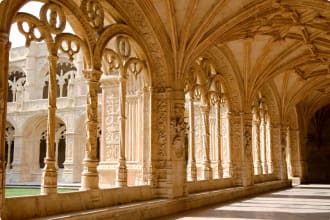
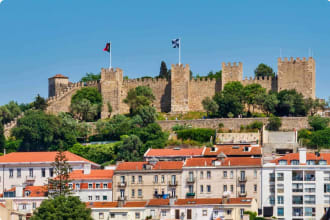
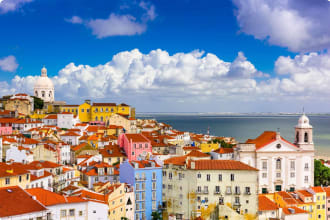
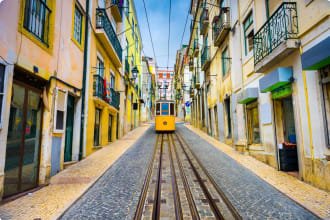
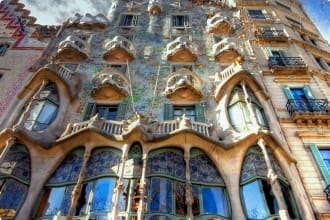
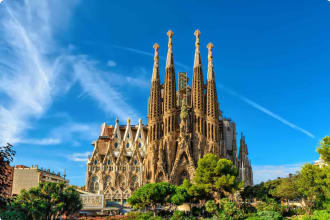
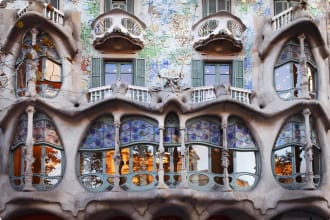
Itinerary
21 days
Day 1: Lisbon
Accommodation: Altis Suites or similar
We make our own way to our accommodation in Lisbon, where the group will meet with the Odyssey Program Leader. This evening the group will enjoy a welcome dinner at a nearby restaurant. (D)
Day 2: Lisbon
Accommodation: Altis Suites or similar
On our first full day in Lisbon, we will go on a guided tour of the neighbourhoods of Alfama and Graca, two of the oldest districts in the city.
We will stroll through the cobbled streets of Alfama and enjoy spectacular views of the city from several viewpoints. Many of the areas can be reached on foot, but as there are several steep streets we can take the tram in certain sections of the tour. This historical tour will include
- entrance to the 12th-century Lisbon Cathedral, the oldest cathedral in the city
- Museum of Aljube, which used to be a prison and is now a museum dedicated to the memory of the struggle against the dictatorship which governed Portugal from 1926 to 1974
- Museum of Roman Theatre, unearthed ruins of the ancient Roman theatre of the city of Olisipo, Lisbon’s origins
- Church of Sao Vicente de Fora, known for having the world’s largest collection of baroque tile art
- Museum of Fado, dedicated to Fado (“fate”), a type of Portuguese expressive and melancholic musical performance traditionally associated with pubs and cafes. The Lisbon style of Fado dates back to the 1830s, and we will experience this performance on Day 3
We will end the day’s tour in the area of the São Jorge Castle (no internal visit) to view the Moorish castle overlooking Lisbon and the Tagus River.
Dinner is at own expense. (B)
Day 3: Lisbon
Accommodation: Altis Suites or similar
Today we will go on a morning guided tour of Fronteira Palace, built in the 17th century and considered one of the most beautiful residences in Lisbon with its spectacular decorative tiles, frescoed panels, and works of art. This private residence of the Marquesses of Fronteira was built in 1671 as a hunting pavilion of the 1st Marquis of Fronteira, Dom João de Mascarenhas.
In the afternoon, we will take a guided tour of the historic Mouraria neighbourhood at the foot of São Jorge (St. George) Castle, birthplace of Lisbon Fado and a vibrant art scene. Mouraria or “Moorish Quarter” was named as such as this became the sanctuary for Muslims after Afonso I reclaimed the city and banished Muslims living inside the castle walls. It continued to become a sanctuary for immigrants through the years, and today it is Lisbon’s most culturally diverse districts. Among the many sights we will see on our tour include the Escadinhas de São Cristovão which has walls of murals dedicated to Fado, and the home of singer Maria Severa Onofriana whose performances brought fame to Fado and lifted her to near-mythical status in Mouraria. She died from tuberculosis at the age of 26 in 1846, and today her old apartment is a fado venue.
In the evening we will have dinner and experience a performance of Fado at a local Fado house (possibly in the cosy Mesa de Frades, which used to be a chapel). (B, D)
Day 4: Lisbon
Accommodation: Altis Suites or similar
Today we will focus on the Portuguese Age of Discovery. We will spend the full day in the Belem neighbourhood, a village located at the mouth of the Tagus River, where Portuguese fleets departed to reach the Atlantic and sail around the globe.
Many of the city’s iconic monuments are located here. We will have a special visit to the Fabrica dos Pasteis de Belem, which has been baking the Portuguese custard tart since 1837. We will have chance to taste this creamy pastry–its secret recipe guarded since the 19th century–and stroll inside the beautiful café-factory.
We will move on to two UNESCO World Heritage Sites–the Jeronimos Monastery, a former monastery of the order of St. Jerome that has since been secularised; and the Tower of Belem, built around 1514 on the banks of the river to defend the port of Lisbon.
We will also explore the Berardo Museum, a museum of modern and contemporary art, and Coaches Museum, which houses a valuable collection of horse-drawn carriages.
Dinner tonight is at own expense. (B)
Day 5: Lisbon
Accommodation: Altis Suites or similar
Today we will enjoy a full day tour of Chiado, Principe Real and Estrela, newer neighbourhoods that offer upscale shops and glimpses into Lisbon’s past. Among the monuments we will visit are the ruins of the Carmo Convent, a Catholic convent destroyed during the Lisbon earthquake of 1755 and which now remains as a reminder of the tragedy. It now houses the Carmo Archaeological Museum, which is dedicated to Portuguese history.
While Carmo Convent was destroyed, Igreja de Sao Roque survived the massive earthquake, and we will visit this as well. Sao Roque was the first Jesuit church constructed in Portugal.
There will also be time to visit Lisbon’s landmark basilica, Basilica da Estrela, have food and perhaps go shopping in Campo de Ourique, and explore the National Museum of Ancient Art, Portugal’s national art museum. (B)
Day 6: Lisbon
Accommodation: Altis Suites or similar
Today is a free day to spend at our leisure. Use this time to relax or see more of the city. (B)
Day 7: Lisbon - Sintra - Lisbon
Accommodation: Altis Suites or similar
From Lisbon, we travel to the city of Sintra, a UNESCO heritage town famous for its 19th century Romantic architecture. Its historic centre is listed as a World Heritage Site. It has many royal palaces and gardens, and early today, to avoid the crowds, we will explore the colourful Pena Palace, located at the top of the hill in the Sintra Mountains. It has a mix of styles running the architectural gamut from neo-Gothic to neo-Renaissance, and is celebrated as the grandest example of Romantic architecture.
We will stop for lunch, possibly at Lawrence’s Hotel restaurant. Lawrence’s Hotel is the oldest hotel on the Iberian Peninsula, and known for lodging several important personalities such as Lord Byron and Portuguese writer Eca de Queiroz.
Still in Sintra, we will visit the magical Quinta da Regaleira, a palace and a chapel set on a hillside, which also showcases an eclectic mix of architectural styles. The property also has fountains, grottoes, statues, caves, and ponds connected above-ground through pathways and below-ground through tunnels lit with fairy lights. We will see the romantic Monserrate Gardens and Palace, which blends Moorish Revival and neo-Gothic architectural styles, before driving back to Lisbon.
(B, L)
Day 8: Lisbon - Obidos - Nazare - Batalha - Lisbon
Accommodation: Altis Suites or similar
Today we will drive to Obidos, where we will enjoy a sightseeing tour. Obidos grew from a Roman settlement and a Moorish fortification, until it was extensively remodelled under Dinis I. Dinis I offered the town to his wife, Isabel, in the 13th century, and its architecture was enriched in the following centuries.
We then continue to the fishing town of Nazare. In Nazare, we will have a guided tour to learn more about the town’s fishing traditions and view the beach famous among surfers the world over for its giant waves. It is not unusual to see fisher women here still wearing traditional clothing: skirt with seven colourful layers (said to represent the days of the week), wooden clogs, and black headscarf.
Before heading back to Lisbon, we will stop at Batalha to visit its impressive monastery built in the Gothic and Manueline (Portuguese Gothic) styles. The Monastery of Batalha was built to commemorate the Portuguese victory over the Castilians at the 1385 Battle of Aljubarrota, ending the Castilian plan to capture the Portuguese throne. (B)
Day 9: Lisbon - Mafra - Ericeira - Azenhas do Mar - Cape Roca - Lisbon
Today we will go on an excursion to Mafra on the west coast, famous for its UNESCO-listed Palace-Convent, an imposing structure conceived by King João V in 1711. The Italian Baroque edifice, built from wealth generated by the gold from the Portuguese colony of Brazil, houses the king’s and queen’s palaces, the royal chapel, a Franciscan monastery, and a huge library containing 36,000 volumes, surrounded by a garden and royal hunting park.
From Mafra we will continue to Ericeira, a beautiful seaside town perched on a cliff overlooking beaches. After some free time exploring the town, the tour will go through the charming village of Azenhas do Mar with its whitewashed houses, and we will stop for a bit to enjoy the stunning views.
We will then transfer to Cape Roca, the westernmost point of mainland Europe. Here, we will enjoy a panoramic view of the Atlantic before transferring back to Lisbon. (B)
Day 10: Lisbon
Accommodation: Altis Suites or similar
This is another free day we can spend at our leisure. Use this time to pack or do some last-minute Lisbon sightseeing as we will be heading to Barcelona tomorrow! (B)
Day 11: Lisbon - Barcelona
Accommodation: Sercotel Amister Art Hotel or similar
We will be taken by coach to the airport to fly to Barcelona.
Upon arrival at Barcelona, we will be transferred to our hotel, where we will also have our group dinner to begin the second leg of our twin city excursions. (B, D)
Day 12: Barcelona
Accommodation: Sercotel Amister Art Hotel or similar
Today will be spent exploring the vibrant city of Barcelona, particularly the Gothic Quarter and the Born neighbourhood, taking advantage of Barcelona’s public transport. A local guide will then take us on a tour of the city. We will visit its central square, Plaça de Catalunya and walk down tree-lined Las Ramblas. Among the places we will explore in the medieval-era streets of the Gothic Quarter are:
- the Jewish Quarter, which has Spain’s oldest synagogue
- the 15th-century Basilica of Santa Maria del Pi
- Barcelona Cathedral, seat of the Archbishop of Barcelona
- Museum of the History of Barcelona
- Basilica Santa Maria Del Mar, an outstanding example of Catalan Gothic
Day 13: Barcelona
Accommodation: Sercotel Amister Art Hotel or similar
Today we will be focusing on the Spanish Civil War. A local guide will take us through a series of sights relating to the war, explaining their relevance and the enormous impact of the conflict on Barcelona itself. The Spanish Civil War began in 1936 and continued until 1939, when the fascist leader Francisco Franco defeated the Republican forces and declared victory. Barcelona was one of the final cities to fall to Franco’s rule, after his invasion of Catalonia. The half-day tour will end with a visit to Castell de Montjuïc, an old hilltop military fortress dating back to the 17th century, and which was used as a prison during the Civil War.
In the afternoon, we will have a tour of Montjuïc, including entrance to the Museu Nacional d’Art de Catalunya.
Our evening can be spent at leisure. We suggest staying to watch the music and light show at the Magic Fountain of Montjuïc before heading back to the hotel. (B)
Day 14: Barcelona
Accommodation: Sercotel Amister Art Hotel or similar
We will go on a market tour of La Boqueria Market, which dates back to the 13th century and a showcase of Barcelona’s gastronomic delights. This will be followed by a cooking class, where we will learn how to prepare traditional cuisine. Lunch will be the sumptuous dishes we will prepare in the cooking class.
We will have some free time until we meet again in the evening for dinner and a flamenco show. (B, L, D)
Day 15: Barcelona
Accommodation: Sercotel Amister Art Hotel or similar
The focus of today’s tour is Barcelona’s most famous resident, Antoni Gaudi (1852-1926). Barcelona is an architecturally wondrous city and perhaps the greatest influence on the city’s style was architect Antoni Gaudi. Gaudi’s style is distinctive and striking. One of his most famous works is the Casa Batlló, a strange skeletal house that is extraordinarily beautiful both inside and out. The Batlló family, who commissioned the house, put no limitations on the architect. It is now open to the public. We will also see the famous Sagrada Familia and the colourful Park Guell. We will also see the unusual Casa Mila also known as La Pedrera or “the stone quarry” due to its rough-hewn appearance. This was the last private residence Gaudi designed. (B)
Day 16: Barcelona
Accommodation: Sercotel Amister Art Hotel or similar
This is a free day to relax or to go exploring the city on your own. (B)
Day 17: Barcelona
Accommodation: Sercotel Amister Art Hotel or similar
This morning we will take a guided tour of the Palau de la Musica Catalana, a concert hall with striking modernist architecture. In the afternoon, we will visit the Picasso Museum, which houses one of the most extensive collections of Pablo Picasso’s artwork, and Palau Guell, a mansion designed by Gaudí for the industrial tycoon Eusebi Güell and another great example of Gaudi’s unique architectural imagination.
(B, D)
Day 18: Barcelona - Montserrat - Sant Sadurni d’Anoia - Barcelona
Accommodation: Sercotel Amister Art Hotel or similar
Today is a full-day excursion to Montserrat. The city is located at the foot of the striking multi-peaked mountain range of the same name (Montserrat in Catalan means “saw mountain”). We will be visiting the Santa Maria de Montserrat on the mountain to view the Virgin of Montserrat, one of the Black Madonnas of Europe. To reach the Benedictine abbey and basilica, we will be taking a cable car ride that will also give us a panoramic view of the city.
This will be followed by a guided tour and tasting at a cava winery in Sant Sadurni d’Anoia before returning to our hotel. (B)
Day 19: Barcelona
Accommodation: Sercotel Amister Art Hotel or similar
Today is a free day to relax before our final full day of sightseeing in the city. (B)
Day 20: Barcelona - Girona - Besalu - Barcelona
Accommodation: Sercotel Amister Art Hotel
Today we will venture out of Barcelona to the ancient Catalan city of Girona to explore the town. Its Museum of Jewish History documents a long history of Judaism in the city, which flourished in the 12th century. It also tells a fascinating story of the city’s history. The Arab Baths are a 12th-century construction inspired by Roman baths and which are still largely intact. We will also see the beautiful Girona Cathedral with its 91 stone steps. Fans of the show Game of Thrones may recognise the Arab Baths and the cathedral steps as some scenes were filmed here.
On the way back to Barcelona we will stop at Besalu, a magnificent example of a charming medieval town.
In the evening we will sit down as a group at a local restaurant for our farewell dinner. (B, D)
Day 21: Barcelona
The end of breakfast also marks the end of the tour and our services. (B)
Includes / Excludes
What’s included in our Tour
- 20 nights of hotel accommodation.
- 20 breakfasts, 2 lunches and 6 dinners.
- Applicable entry fees and services of local guides.
- Touring by comfortable and modern coach.
- Field trips as indicated.
- Gratuities and necessary tips.
- Services of an Odyssey program leader.
- Detailed tour information booklet.
What’s not included in our Tour
- Return international airfare and departure taxes.
- Comprehensive international travel insurance.
- Items of a personal nature such as telephone calls and laundry.
- Meals not specified in the itinerary.
Participants must be able to carry their own luggage, climb and descend stairs, be in good health, mobile and able to participate in 3-5 hours of physical activity per day, the equivalent of walking / hiking up to 8 kilometers per day on uneven ground.
Book now
Make it a private tour
Easing your journey
Crossing international borders with restrictions
The list of requirements to travel internationally has changed and will continue to change for several years. Odyssey is here to assist you in managing your way through these requirements:
For more information see our Crossing international borders with restrictions page.
Book With Confidence
If less than 30 days before your tour starts you are unable to travel as a result of Government travel restrictions, Odyssey Traveller will assist you with a date change, provide you with a credit or process a refund for your booking less any non-recoverable costs.
See Terms and conditions for details.
Peace of Mind Travel
The safety of our travellers, tour leader, local guide and support staff has always been our top priority and with the new guidelines for public health and safety for keeping safe for destinations around the world, we’ve developed our plan to give you peace of mind when travelling with us.
See Peace of Mind Travel for details.
Reading List Download PDF
Queen of the Sea: A History of Lisbon
Barry Hatton
Lisbon's charm is legendary, but its vibrant 2,000-year history is not widely known, from its Roman legacy to its centuries under Moorish rule. Its journey from port town to Portugal's capital was not always smooth sailing--in 1755 the city was devastated by the largest earthquake ever to strike modern Europe, followed by a catastrophic tsunami and a six-day inferno that turned sand to glass.
Barry Hatton unearths these forgotten memories in a vivid account of Lisbon's colourful past and present, bringing to life the 1147 siege during the Iberian reconquista, the assassination of the king, the founding of a republic and the darkness of a modern dictatorship. He reveals the rich, international heritage of Portugal's metropolis--the gateway to the Atlantic and the unrivalled Queen of the Sea.
Barcelona
This is not a proper guidebook. Think of it as a checklist scribbled on a napkin by a friend who lives in Barcelona and would like you to see the best of the city. Quickly plan your itinerary here – museums, coffee stops, lunch and dinner, a bit of shopping – and hit the streets well-prepared. We’ve included more than 180 tips on restaurants, bars, cafes, landmarks and things to do, a primer on Barcelona and Catalonia, a few gift ideas, basic travel information and several beautiful maps to get your bearings right.
Forgotten Places: Barcelona and the Spanish Civil War
Nick Lloyd
A guide to Barcelona in the Spanish Civil War, beginning in the 19th century with the conditions and movements which led to the revolution of 1936, and ending with the fall of the city on 26th January 1939 when Franco's tanks drove down the Diagonal and set about destroying everything the Republic had built. Stories from the aftermath of the war, the exile and the Franco regime are also included.
In addition with dealing with the more obvious themes such as anarchism, the Spanish Republic, Catalonia, George Orwell, the aerial bombing, and the May Days, etc, the book also looks at themes such as the Zoo during the Civil War, the American Sixth Fleet in the city, Barça, urbanism, Nazis in Barcelona, Robert Capa, the Spanish in the Holocaust, poster art...
Intertwined in the text are contemporary quotes and a few personal stories of people I have met who experienced the war or its aftermath. There are also biographies of characters such as Andreu Nin and Lluís Companys.
A Concise History of Spain
William D. Phillips Jr and Carla Rahn Phillips
The rich cultural and political life of Spain has emerged from its complex history, from the diversity of its peoples, and from continual contact with outside influences. This book traces that history from prehistoric times to the present, focusing particularly on culture, society, politics, and personalities. Written in an engaging style, it introduces readers to the key themes that have shaped Spain's history and culture. These include its varied landscapes and climates; the impact of waves of diverse human migrations; the importance of its location as a bridge between the Atlantic and the Mediterranean and Europe and Africa; and religion, particularly militant Catholic Christianity and its centuries of conflict with Islam and Protestantism, as well as debates over the place of the Church in modern Spain. Illustrations, maps, and a guide to further reading, major cultural figures, and places to see, make the history of this fascinating country come alive.
The Ornament of the World: How Muslims, Jews, and Christians Created a Culture of Tolerance in Medieval Spain
Maria Rosa Menocal
A brilliant and fascinating portrait of medieval Spain explores the golden age when Muslims, Jews, and Christians lived together in an atmosphere of tolerance
The Story of Spain: The Dramatic History of Europe's Most Fascinating Country
Mark R. Williams
The book is a popular history of Spain and the Spanish Empire from prehistoric times to the present day. It provides description and analysis of political, social, economic and cultural events over the centuries, which together shaped the history of this distinctive country. The book offers 60 illustrations and maps, including 16 pages of color photographs, as well as lists of historic places to visit at the end of each chapter. There is a dynastic chart, suggested readings, and index.
Muslim Spain and Portugal: A Political History of al-Andalus
Hugh Kennedy
This is the first study in English of the political history of Muslim Spain and Portugal, based on Arab sources. It provides comprehensive coverage of events across the whole of the region from 711 to the fall of Granada in 1492. Up till now the history of this region has been badly neglected in comparison with studies of other states in medieval Europe. When considered at all, it has been largely written from Christian sources and seen in terms of the Christian Reconquest. Hugh Kennedy raises the profile of this important area, bringing the subject alive with vivid translations from Arab sources. This will be fascinating reading for historians of medieval Europe and for historians of the middle east drawing out the similarities and contrasts with other areas of the Muslim world.
Journey to Portugal: In Pursuit of Portugal's History and Culture
Jose Saramago
When José Saramago decided to write a book about Portugal, his only desire was that it be unlike all other books on the subject, and in this he has certainly succeeded. Recording the events and observations of a journey across the length and breadth of the country he loves dearly, Saramago brings Portugal to life as only a writer of his brilliance can. Forfeiting the usual sources such as tourist guides and road maps, he scours the country with the eyes and ears of an observer fascinated by the ancient myths and history of his people. Whether it be an inaccessible medieval fortress set on a cliff, a wayside chapel thick with cobwebs, or a grand mansion in the city, the extraordinary places of this land come alive.
Always meticulously attentive to those elements of ancient Portugal that persist today, he examines the country in its current period of rapid transition and growth. Journey to Portugal is an ode to a country and its rich traditions.
Conquerors: How Portugal Forged the First Global Empire
Roger Crowley
In Empires of the Sea and City of Fortune, New York Times bestselling author Roger Crowley established himself as our generation’s preeminent historian of the great European seafaring empires, and the go-to author for post-Crusade clashes of East and West. Now, in Conquerors, Crowley gives us the epic story of the emergence of Portugal, a small, poor nation that enjoyed a century of maritime supremacy thanks to the daring and navigational skill of its explorers—a tactical advantage no other country could match. Portugal’s discovery of a sea route to India, campaign of imperial conquest over Muslim rulers, and domination of the spice trade would forever disrupt the Mediterranean and build the first global economy.
Crowley relies on letters and eyewitness testimony to tell the story of tiny Portugal’s rapid and breathtaking rise to power. Conquerors reveals the Império Português in all of its splendor and ferocity, bringing to life the personalities of the enterprising and fanatical house of Aviz. Figures such as King Manuel “the Fortunate,” João II “the Perfect Prince,” marauding governor Afonso de Albuquerque, and explorer Vasco da Gama juggled their private ambitions and the public aims of the empire, often suffering astonishing losses in pursuit of a global fortune. Also central to the story of Portugal’s ascent was its drive to eradicate Islamic culture and establish a Christian empire in the Indian Ocean. Portuguese explorers pushed deep into the African continent in search of the mythical Christian king Prester John, and they ruthlessly besieged Indian port cities in their attempts to monopolize trade.
The discovery of a route to India around the horn of Africa was not only a brilliant breakthrough in navigation but heralded a complete upset of the world order. For the next century, no European empire was more ambitious, no rulers more rapacious than the kings of Portugal. In the process they created the first long-range maritime empire and set in motion the forces of globalization that now shape our world. At Crowley’s hand, the complete story of the Portuguese empire and the human cost of its ambition can finally be told.

